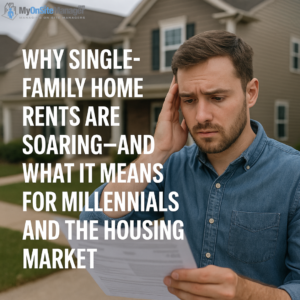 Renters across America are facing steeper costs — but especially those who are seeking single-family homes. According to a recent report from Zillow, rental prices for single-family homes have surged by a staggering 41% since the pandemic began, compared to a 26% rise in apartment rents.
Renters across America are facing steeper costs — but especially those who are seeking single-family homes. According to a recent report from Zillow, rental prices for single-family homes have surged by a staggering 41% since the pandemic began, compared to a 26% rise in apartment rents.
As of January 2025, the average rent for a single-family home reached $2,179, while the average apartment rent stood at $1,820. This growing gap highlights a major shift in housing affordability, making it increasingly challenging for renters who are looking for the space, privacy, and lifestyle that single-family homes offer.
Several key factors are fueling this surge:
-
High Mortgage Rates: Elevated mortgage rates have pushed many would-be buyers out of the market, forcing them to rent longer than they originally planned.
-
Limited Housing Supply: The supply of newly built single-family homes has not kept up with demand, especially as construction slowed during and after the pandemic.
-
Changing Demographics: Millennials, who now represent a major share of first-time homebuyers, are encountering affordability challenges, delaying homeownership and increasing rental demand for larger living spaces.
These dynamics have created a perfect storm — increasing competition for single-family rentals and driving prices even higher.
Millennials: Stuck Between Renting and Homeownership
The rise in single-family rental costs is hitting millennials particularly hard. As the average age of first-time homebuyers climbs (now around 38 years old), millennials are finding themselves caught in a rental market that feels increasingly out of reach.
Many millennials are looking for the lifestyle traditionally associated with homeownership — larger living spaces, backyards, and family-friendly neighborhoods — but without the ability to purchase a home due to:
-
Soaring home prices
-
High mortgage interest rates
-
Mounting student loan debts
-
The rising costs of living and childcare
As a result, many are turning to single-family rentals as a “middle ground.” However, renting a house often comes with tougher financial requirements than renting an apartment. Applicants usually need a strong credit score, stable income, and a low debt-to-income ratio, making it harder for some renters to qualify.
Zillow’s report also notes that rental growth for single-family homes is strongest in more affordable suburban markets — signaling that renters are seeking larger homes but are being pushed farther from city centers to find them.
Broader Implications for the Housing Market
The dramatic increase in single-family rental prices signals deeper challenges within the U.S. housing market:
-
Affordability Crisis: With rents consuming a larger share of household incomes, more Americans are at risk of becoming financially strained. In some markets, it’s not unusual for renters to spend more than 30% of their income on housing — the threshold considered “cost-burdened.”
-
Supply Shortages: Without sufficient new construction of both for-sale and rental housing, pressure will continue to build. In some areas, housing supply is still well below pre-pandemic levels.
-
Delayed Homeownership: Homeownership has long been seen as a path to building long-term wealth. With millennials and Gen Z delaying this step, it could have ripple effects on future wealth accumulation, retirement security, and overall economic mobility.
-
Increased Suburbanization: As renters seek more affordable options, there’s a growing shift toward suburban areas, changing the demographic and economic landscape of these communities.
Tips for Navigating the New Rental Market
For renters considering a single-family home in today’s market, preparation is key:
-
Strengthen Your Finances: Before applying, work on boosting your credit score, reducing debt, and ensuring you can demonstrate stable income.
-
Be Ready to Act Quickly: Desirable rental homes move fast. Having all your application materials (proof of income, references, credit report) ready to go can give you a competitive edge.
-
Expand Your Search: Consider nearby suburbs or less densely populated areas where rent prices might be more reasonable.
-
Think Long-Term: With rents continuing to rise, it might be worth calculating whether saving aggressively for a down payment could be a better financial strategy in the long run.
-
Negotiate Lease Terms: In some cases, offering a longer lease (18–24 months) can make you a more attractive tenant and may help you lock in today’s rental rate before further increases.
Conclusion
The rising cost of renting single-family homes is more than just a temporary trend — it’s a reflection of deeper shifts in the American housing market. For millennials and other prospective homebuyers, it presents tough choices between renting longer, moving farther from city centers, or adjusting expectations about homeownership.
As Zillow’s latest report shows, the path to securing the perfect home — whether rented or owned — is becoming increasingly complex. For now, being financially prepared, flexible, and informed will be critical for navigating this challenging landscape.
Source: Fortune – Rent prices increasing for single-family homes, Zillow report
